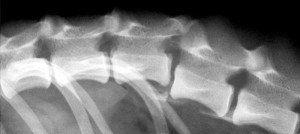News
Spinal Fractures
by admin on August 1st, 2019
Category: News, Tags:
Spinal Fractures
Fractures (breaks) of the spine occur when dogs and cats are involved in road traffic accidents or suffer other major trauma such as a fall or running into a patio door. Spinal fractures are often associated with varying degrees of injury to the spinal cord (the bundle of nerves inside the vertebrae) and, therefore, nerve damage. Although many animals may be paralysed as a result of the fracture, they will often recover, provided that they retain the ability to feel pain and that they are managed appropriately. Some cases can be treated medically, but it is often necessary to consider surgery to stabilise a fractured spine.
What is involved in a spinal fracture?
In a spinal fracture, the bones (vertebrae) of the spine break (fracture) or come apart from each other (dislocate or luxate). Fracture of the spine usually occurs as a result of a significant injury, such as being hit by a car, although occasionally the bones in the spine may fracture with minimal, if any, trauma because they are already weakened by a condition such as a tumour (referred to as a ‘pathological fracture’).
When the vertebrae of the spine fracture or dislocate (luxate) the associated vertebral displacement often injures the nerves of the spinal cord. The concussion and compression of the spinal nerves affects nerve function, and the signs that develop may vary from only mild weakness through to paralysis (inability to voluntarily move the limbs). Severely affected patients may become incontinent and lose the ability to feel pain in their limbs and tail.
How are spinal fractures diagnosed?
Physical examination of the patient by the specialist may enable detection of instability of the spine or abnormal alignment of the spine. Importantly, examination also enables assessment of the severity of any associated spinal cord injury – in particular, whether or not the patient can still feel pain.
X-rays (radiographs) are often obtained to look for evidence of fracture (or luxation) of the vertebrae and are generally sufficient to make a diagnosis in the majority of cases. Occasionally a more advanced imaging technique is preferred, to provide additional detail of the spine. CT scanning is particularly good at looking at the bony detail of fractures which may not be apparent on normal X-rays. MRI scanning is not so good at detecting damage to bones of the spine, but it is excellent for assessing any damage to the spinal cord.
How are spinal fractures managed?
Spinal fractures (and luxations) are often emergencies because of the associated spinal cord injury and risk of further damage. As a result, they need to be treated with the minimum of delay. Affected dogs and cats are often in significant pain, and care should be taken to avoid the handler being bitten or scratched. Patients should be moved with great caution in case the spine (vertebral column) is unstable, as further movement may aggravate the injury and any nerve damage. Strapping the patient to a rigid board may be helpful in some cases.
Some fractures of the spine may be treated conservatively without the need for surgery. This is particularly appropriate in patients with relatively stable vertebrae and minimal spinal cord injury. Conversely, dogs and cats with unstable fractured spines, those with significant spinal cord injuries and those in severe pain are often best treated surgically. Surgery aims to re-align and stabilise the affected vertebrae. The procedure most often involves placing screws or pins in the bones on either side of the fracture (or luxation) and securing them with either a plate or cement.
What is the outlook (prognosis) in patients with spinal fractures?
The outlook in dogs and cats with spinal fracture is primarily dependent on the severity of the spinal cord injury and how the patient is treated. Provided the ability to feel pain in the limbs and tail is maintained and the patient is managed appropriately, the outlook is generally good. Recovery may take a number of weeks (or even months in severely affected cases) and supportive care, including physiotherapy/hydrotherapy exercises, may be necessary. In contrast, patients with spinal fractures that can no longer feel pain are very unlikely to recover, no matter how they are treated, since the spinal cord injury is generally severe and irreversible.


